
|
 |
|||||||||||
|
|
|
|
|
|
|
|||||||
|
Mauritius information
|
|
ACCOMMODATION
|
RESTAURANTS
|
NIGHTLIFE
|
EXCURSIONS
|
VISIT
|
DRIVE
|
|
|
Introduction
"In Mauritius we cultivate sugar cane and prejudices", Malcolm de Chazal (1902-1981). The visitor may keep this in mind during his or her stay in Mauritius as it may help to better understand the country and its people. Let's add a drop of humility and take off our pink sunglasses. Mauritius is still at the stage of a developing country with several challenges coming forward. It is with this in mind that one can properly appreciate the exotic colours of Mauritius and especially the humble gentleness of its people which, let's face it, has been the main asset of the tourism industry so far. |
|
Mauritius is a volcanic island situated in the Indian Ocean far off the west coasts of Madagascar, by 20.30 degrees South and 57 degrees East. Mauritius is part of the "Mascarene" islands. Its area is of 2,040 Km2 and is surrounded by coral reefs and lagoons. Mauritius has the status of an independent Republic with a democratic regime based on the Westminster model. The main political parties adopt a modern socialism ideology, that is, with a pinch of capitalism. Mauritius is a reliable and safe destination, well organised to receive the average 900,000 visitors yearly. (See our write-up about security in Mauritius.) |
|
Mauritius has a tropical climate with more rain in summer than in winter. Generally hot (27 to 37 °C in summer) and very humid (above 80 %) with a high rainfall, Mauritius has microclimates; the high grounds are cooler (av. 22 °C) and much wetter (5,000 mm / year) than the coastal regions (1,000 mm / year). Which region is best? Myths As regards to climate only, our main advice is to opt for the South and East coasts for stays during the 4 warmest months of the year; the downwind coasts being simply steam stoves. In winter (June to September,) the prevailing winds blowing South-east to East, make the East and South coasts less attractive. Days being already quite short, the fact that the sun goes to set on the land side makes the days seem even shorter. As it remained relatively in its original state, the East coast in winter will better suit the early birds and nature lovers. Having said that, not all beaches of all the hotels and villas of the East coast are wind-facing. This coastline counts several tiny coves which are North-facing, therefore very sheltered and warm in winter. The North coast is the one which has the most stable and tempered weather conditions although very hot on summer afternoons. The vast majority (but not all) of its beaches are West-facing, offering magnificent sunsets; highly pleasant moment of the day, even in winter. As regards to other aspects (quality of the lagoons, views, tranquillity,) it would not be sound to apply general rules as it really changes from a precise location to another. When selecting your accommodation, make sure you locate it on a map and make sure that the pictures of the beach front match the satellite views. The West coast is warm to very warm all year round but in several places there is a thermal sea breeze picking up, cooling the early afternoons. The West coast offers the widest choice of activities with some nice beaches surf and kitesurfing spots (Le Morne,) the Black River Gorges natural park, its typical villages and restaurants. |
|
Mauritius has never been a colony in real terms, as it was originally inhabited.
10th century: The Arab navigators call in Mauritius several times while exploring the regions off their costs. 1500. Portuguese "discover" the island and calls it "Ilha do Cirne" (Swan Island) and abandon it later. 1512. In turn, the British sailors discovered the island. 1598. The Dutch take over the island and call it "Mauritius" in honour of Maurits van Nassau, governor of the Orange state in Southern Africa.  1638. After having used the island on and off for repairing ships and as temporary shelter for their fleets the first Dutch settlers arrive in Mauritius to create a colony. 1639. Introduction of the sugar cane. 1658. The Dutch abandon the island. 1664. The Dutch come back for another try. 1710. The Dutch abandon the island definitely, after having destroyed a vast amount of ebony trees and the Dodo and leaving behind sugar cane plants, coconut trees, dears from Java, cows, pigs, hens, and... the stray dogs, one of the peculiarities of Mauritius. 1715. The French take over the island and name it "Isle de France". 1719. The king Louis XV concedes the island to the almighty "Compagnie des Indes." 1721. Arrival of the first French settlers. 1735. Arrival of "Mahé de Labourdonnais," as Governor of the island for the account of the "Compagnie des Indes." 1735. Mahé de Labourdonnais decides to develop Port Louis as main port and administrative centre. 1745. The first export orientated sugar mills are created. Although the sugar cane was introduced since 1639, it was mostly used for the making of spirits greatly appreciated by the sailors. The sugar production was mainly for the local consumption and for the crews. 1764. The "Compagnie des Indes" going bankrupt, Louis XV buys back the island. 1767. Arrival of the first royal officers acting as governors. 1790. The settlers learn with great pleasure about the French revolution. 1792. The revolutionary French authority orders the abolition of slavery. The Settlers refuse to abide leading to a breach of relationships with the French government. 1800. Witnessing a great English activity in the whole Indian Ocean, the settlers ask the Napoleon administration for protection against the invaders. 1803. Arrival of Decaen and the creation of a Military authority. Decaen came up with an anti-revolutionary plan where the practice of slavery was no more an offence and re-established the former racial segregation between whites and others. On the other hand, Decaen allowed the runaway slaves to live freely and supported the observance of religions other than Christianity, such as the Tamil, Hindu and Muslim religions. 1810. The great "Vieux Grand Port" naval battle took place. This battle is famous as it was the only naval battle won by the French over the English. 1810. Despite the outcome of the "Vieux Grand Port" battle, the English strike again, this time landing in Cap-Malheureux and take over the defenceless Island. The capitulation occurred overnight as both the French and English had the means to open a fight. The French agreed to surrender conditionally that the French settlers could keep their land, belongings, status and culture. It is for this reason that to day, French is more widely spoken in Mauritius while the official language is English since 1832. 1810. The Island takes its definite name of Mauritius. 1835. Abolition of slavery. 1864 - 1929. Mauritius follows the Industrial revolution and sets its first railway receives its first car and discovers the telephone and electricity. 1929. Economic crisis due to the development of sweet beetroot sugar in Europe. 1934. Creation of the Mauritian Rupee. 1936. The creation of the first political (labour) party. 1937. The first strike takes place where field workers fight the landlords and the state makes the use of troops to re-establish law and order. 1941. Building of the Plaisance airport for the use of the RAF. 1947. First passenger flight from France lands in Mauritius after a three-day trip. 1948. The Labour party wins the first election. 1959. Sir. Seewoosagar Ramgoolam with the labour party wins the first open election. 1963. Sir. Seewoosagar Ramgoolam wins again this time as leader of the labour party, marking the definitive take-over of the political scene by the Hindus. 1967. The Mauritians opt for Independence proposed by the Labour party. 1968. While the past year saw many fights and resistance from the anti-independent Franco Mauritians, more ethnic fights occur namely between the Creoles and the Muslims. 1968. The independence nonetheless takes effect. 1992. Mauritius achieves the status of Republic. The governor, representative of the Queen of England, is named President of the Republic. |
|
There is a polemical issue on the so-called private beaches. Most of the beaches of Mauritius are found in front of private residences or hotels, leaving very little room to the declared public beaches.
Exportal Ltd
Email:
Phone: +230 5421 1070
Royal Road, Haute Rive
Rivière du Rempart, Mauritius
By Bernard Cayeux
|

Mauritius Information | Images of Mauritius | Mauritius Map | RSS Feeds | Sitemap | Contact us | About us
Advertise with us | General Conditions | Tourism | Holidays | Destinations | Travel | Vacations | Villas Rentals
| Tweet | Follow @tropicscope |
© Copyright 2008-2015, All rights reserved.







